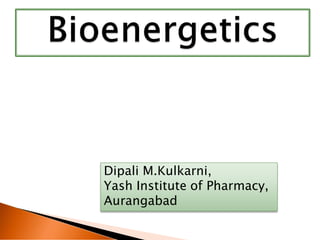The document discusses key concepts in bioenergetics including:
1) Bioenergetics concerns the energy involved in making and breaking chemical bonds in molecules, which is fundamental to biological processes like growth that depend on energy transformations.
2) The first law of thermodynamics states that energy is conserved, while the second law states that entropy increases, reducing the available free energy.
3) Free energy (G) expresses the energy available to do work and depends on enthalpy (H) and entropy (S) changes. Exergonic reactions release free energy while endergonic reactions absorb it.







![Gibbs change in free energy (ΔG )is that portion of the total
energy change in a system available for doing work.
It is also known as the chemical potential .
ΔG= ΔH - TΔS.
Useful energy = change in Enthalpy – change in entropy
[∆G = Gibbs change in Free Energy; ∆H = Change in
Enthalpy; T = Temperature in K; ∆S = Change in Entropy]
Enthalpy, H, is the heat content of the reacting system.
It reflects the number and kinds of chemical bonds in the
reactants and products
The units of ΔG and ΔH are joules/mole or calories/mole
(recall that 1 cal equals 4.18 J);
Entropy, S, is a quantitative expression for the randomness or
disorder in a system.
units of entropy are joules/mole•degree Kelvin (J/mol•K)](https://image.slidesharecdn.com/unit1bioenergetics-220315091126/85/Unit-1-bioenergetics-8-320.jpg)












